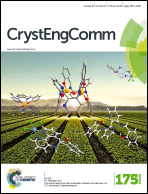Crystal structure, magnetism, and dielectric properties based on the axially chiral ligand 2,2′-dinitro-4,4′-biphenyldicarboxylic acid†
Abstract
Six novel metal–organic-frameworks (MOFs), [Ni(nbpdc)(4,4′-bpy)(H2O)]n (1), [Ni2(nbpdc)2(4,4′-bpy)2(H2O)2]n (2), [Ni(nbpdc)(4,4′-bpy)]n (3), [Mn(nbpdc)(4,4′-bpy)]n (4), [Co(nbpdc)(4,4′-bpy)]n (5), and [Zn2(nbpdc)2(4,4′-bpy)]n (6), with different crystal structures and divalent cations (Zn(II), Ni(II), Mn(II), and Co(II)) from the same ligands nbpdc and 4,4′-bpy (H2nbpdc = 2,2′-dinitro-4,4′-biphenyldicarboxylic acid, 4,4′-bpy = 4,4′-bipyridine) have been synthesized and characterized. Complex 1 showed a new point group of 222 and a new topology structure of sqc6. Crystal structures of complexes 2–6 with the same nonpolar point group of 2/m were determined by single-crystal X-ray diffraction. Complex 2 exhibited a rare three-interlude 3D structure with (44·62)(48·66·8) topology. Complexes 3–5 featured the same topology structure of (44·610·8)(44·62). Complex 6 had a 3D framework with (10)(6·82·103·124)2(62·8)2(8)2 topology. In addition, complex 1 displayed commendable adsorption of N2 at room temperature. 4 and 5 showed antiferromagnetism. Moreover, all six MOFs displayed abnormal dielectric peaks from 225 K to 275 K, which were measured at various frequencies and temperatures.


 Please wait while we load your content...
Please wait while we load your content...